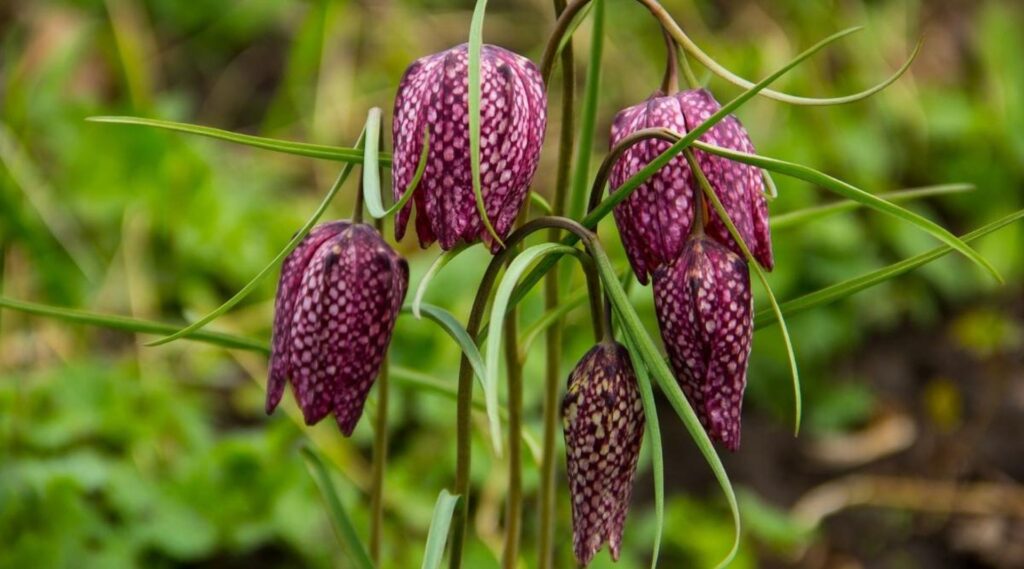Fritillaria meleagris, commonly known as the checkered lily, is a captivating flower that brings a touch of whimsy to any garden. Its unique checkered pattern makes it a standout among spring blooms. This article aims to provide a comprehensive guide to understanding, growing, and caring for this fascinating plant.
Origins and History
The checkered lily is native to Europe and has been a part of traditional gardens since the 16th century. Its botanical name, Fritillaria meleagris, is derived from the Latin word ‘fritillus,’ meaning dice-box, which aptly describes its checkered pattern. If you’re keen on starting a flower garden, the checkered lily is a must-have.
Botanical Description
The checkered lily is a perennial plant that grows up to 30-40 cm in height. The flower has a bell-like shape and comes in various colors, including purple, white, and sometimes pink. The petals have a unique checkered pattern, making it a visual delight. The plant generally blooms in the spring, adding a splash of color to your garden.
Growing Conditions and Care
Understanding the growing conditions and care requirements for the checkered lily is crucial for its successful cultivation. The plant prefers well-draining soil and thrives in a sunny to partially shaded location. It’s relatively low maintenance, making it perfect for both novice gardeners and those with a green thumb.
Soil Requirements
The checkered lily prefers soil that is rich in organic matter but also well-draining. Heavy clay or overly sandy soils are not ideal. A balanced pH level ranging from 6.0 to 7.0 is also recommended for optimal growth.
Sunlight and Watering
The plant thrives in full to partial sunlight. However, it can tolerate some shade, especially in hotter climates. As for watering, the checkered lily prefers soil that is consistently moist but not waterlogged. Overwatering can lead to root rot, which is detrimental to the plant.
Fertilization
A balanced fertilizer can be applied in the early spring to encourage blooming. However, excessive fertilization can lead to lush foliage at the expense of flowers, so moderation is key.
Designing with Checkered Lilies
The unique appearance of the checkered lily makes it a favorite for garden designs. Whether as a focal point or a complement to other spring blooms, this flower adds a touch of elegance and whimsy. When designing a flower and vegetable garden, consider adding checkered lilies for a touch of charm.
Propagation and Preservation
Checkered lilies propagate through their bulbs. After the flowering season, the bulbs can be dug up, divided, and replanted. This ensures a garden full of these beauties year after year.
Pest and Disease Management
While the checkered lily is relatively resistant to most common garden pests, it’s still essential to keep an eye out for signs of infestation. Aphids and spider mites can occasionally be a problem. As for diseases, the plant is generally healthy but can suffer from root rot if overwatered.
FAQs
Common Names
- What are the common names for the checkered lily?
The checkered lily is also known as the Guinea hen flower, checkerboard fritillary, and snake’s head fritillary.
Varietal Differences
- How does the checkered lily differ from other fritillaria varieties?
The checkered lily is distinct from other fritillaria species in its size, color patterns, and blooming period. To learn about a related species, you can visit Wikipedia’s page on the Chocolate Lily.
Growing Conditions
- What are the ideal growing conditions for the checkered lily?
The checkered lily thrives in full sun to partial shade and prefers organically rich, moist but well-drained soil.
Conclusion
In summary, the checkered lily is a unique and captivating flower that deserves a spot in every garden. Its beauty, versatility, and low maintenance make it an excellent choice for both novice and experienced gardeners alike. For those looking to add a touch of Europe to their gardens, the checkered lily, along with other bulbs, can bring inspiration from the Keukenhof Gardens right to your backyard.

